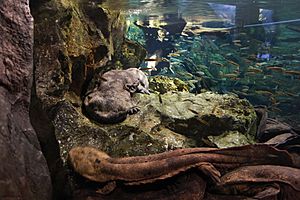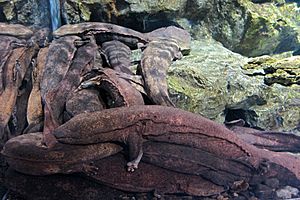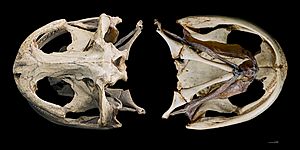Japanese giant salamander facts for kids
Quick facts for kids Japanese giant salamander |
|
|---|---|
 |
|
| In Kyoto Aquarium | |
| Conservation status | |
| Scientific classification | |
| Genus: |
Andrias
|
| Species: |
japonicus
|
| Synonyms | |
|
|
The Japanese giant salamander (Andrias japonicus) is a very large type of salamander. It belongs to a special group of salamanders called Cryptobranchidae. This amazing creature lives only in Japan. In Japan, it is known as Ōsanshōuo, which means "giant pepper fish".
This salamander can grow up to 1.5 meters (5 feet) long! This makes it the third-largest salamander in the world. Only its close relatives, the Chinese giant salamander and the South China giant salamander, are bigger. There are only five known types of giant salamanders in the world. These include the Japanese, Chinese, and South China giant salamanders. There's also an undescribed species from China and the hellbender from North America.
Japanese giant salamanders live in rivers across southwestern Japan. Sometimes, they mix with Chinese giant salamanders that were brought to Japan.
Contents
What Does It Look Like?
The Japanese giant salamander can grow to be about 1.5 meters (5 feet) long. It can weigh up to 25 kilograms (55 pounds). The biggest one ever found in the wild weighed 26.3 kg (58 lb) and was 136 cm (4.5 ft) long. It is the third-largest amphibian on Earth. Only the South China giant salamander and the Chinese giant salamander are larger.
Its skin is a mix of brown and black colors. This helps it blend in with the rocks and mud at the bottom of streams and rivers. It has very tiny eyes with no eyelids. Its eyesight is not very good. Its mouth is very wide, stretching across its whole head. It can open its mouth as wide as its body!
This salamander has large folds of skin on its neck. These folds make its skin surface area bigger. This helps it breathe underwater. It takes in oxygen and releases carbon dioxide through its skin. Tiny blood vessels close to the skin's surface help with this gas exchange.
You can tell the Japanese giant salamander apart from the Chinese giant salamander. Look at the bumps on its head and throat. The Japanese one has more and larger bumps. The Chinese one has fewer, scattered bumps. The Japanese salamander also has a more rounded snout. Its tail is a bit shorter too.
It is hard to tell male and female salamanders apart just by looking at them.
Behavior and Lifestyle
Japanese giant salamanders live only in streams with clear, cool water. They are very large and do not have gills as adults. So, they need to live in moving water where there is lots of oxygen. They spend their entire lives underwater. They are also mostly active at night.
Unlike many other salamanders, they do not lose their gills early in life. They only poke their heads out of the water to get air. They do not come out onto land. They get most of their oxygen through their skin. The many folds in their skin help them absorb more oxygen.
When a Japanese giant salamander feels threatened, it can release a strong-smelling, milky liquid. This liquid smells like Japanese pepper. This is why it's called "giant pepper fish" in Japan.
They have very poor eyesight. But they have special sensory cells all over their skin. These cells form a system called the lateral line. These hair-like cells can feel tiny movements in the water. They are like the cells in our ears that help us hear. This special sense helps them hunt for food because they cannot see well.
They mostly eat insects, frogs, and fish. They have a very slow metabolism. This means they can go for weeks without eating anything! They do not have many natural enemies. These salamanders can live a very long time. One salamander lived for 52 years in a zoo in the Netherlands. In the wild, they might live for almost 80 years!
Life Cycle and Reproduction
Japanese giant salamanders stay in water their whole lives. In late August, during mating season, adult salamanders travel upstream into the mountains. There, they lay their eggs.
Large male salamanders guard a special den. These males are called "denmasters." They mate with several females during the season. Smaller males that do not have a den might try to sneak into the den. They try to fertilize some of the eggs. The male releases a fluid called milt over the eggs laid by the female.
The denmaster takes care of the eggs. He guards them and fans water over them with his tail. This helps bring more oxygen to the eggs. Baby salamanders, called larvae, hatch from the fertilized eggs. These larvae grow gills and limbs. Later, they lose their gills when they change into adult salamanders.
The Asa Zoo of Japan was the first place to successfully breed Japanese giant salamanders in captivity. Some of their babies were sent to the National Zoo in the United States. This helped start a breeding program there. The Hanzaki Institute of Japan has also successfully bred these salamanders. They used the same methods as the Asa Zoo, creating artificial dens for them.
History and Protection
Europeans first learned about the Japanese giant salamander in the 1820s. A doctor named Philipp Franz von Siebold captured one on Dejima Island in Nagasaki. He sent it back to the Netherlands.
In 1951, the species was named a special natural monument in Japan. This means it is protected by the government.
Status and Conservation
The Japanese giant salamander faces many threats. These include pollution and losing its home. Rivers where they live are getting filled with dirt, which is called silting. Dams also block their paths when they try to migrate.
The IUCN says the Japanese giant salamander is "Near Threatened". This means it could become endangered soon if we don't protect it. It is also listed on CITES Appendix I. This means international trade of this animal is highly restricted.
You can find these salamanders on the Japanese islands of Kyūshū, Honshū, and Shikoku. In the past, people used to catch them for food. But now, hunting them is not allowed because of protection laws.
Since 1952, the Japanese Agency for Cultural Affairs has protected the Japanese giant salamander. It is considered a special natural monument because of its cultural and educational importance.
Images for kids
See also
 In Spanish: Salamandra gigante japonesa para niños
In Spanish: Salamandra gigante japonesa para niños






